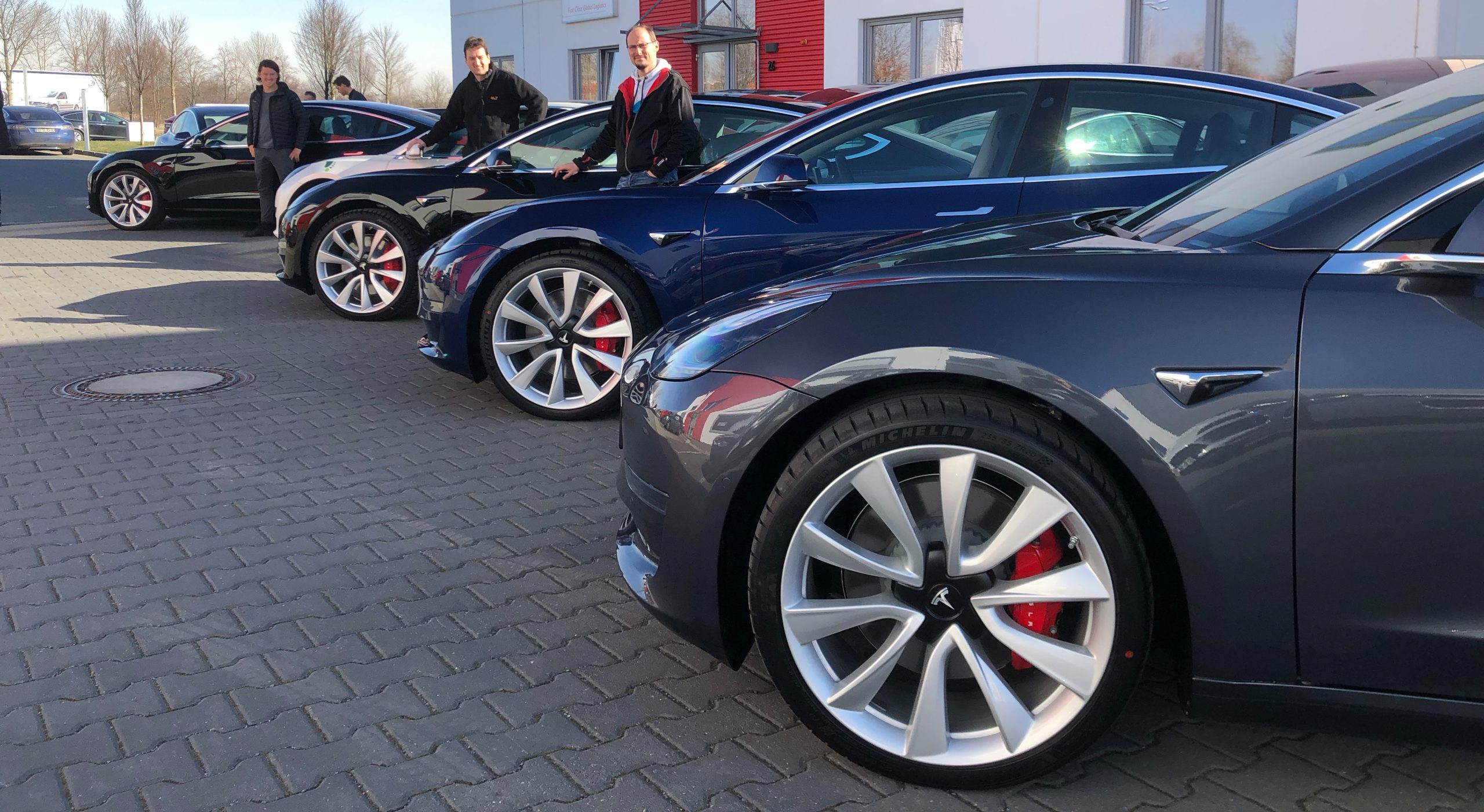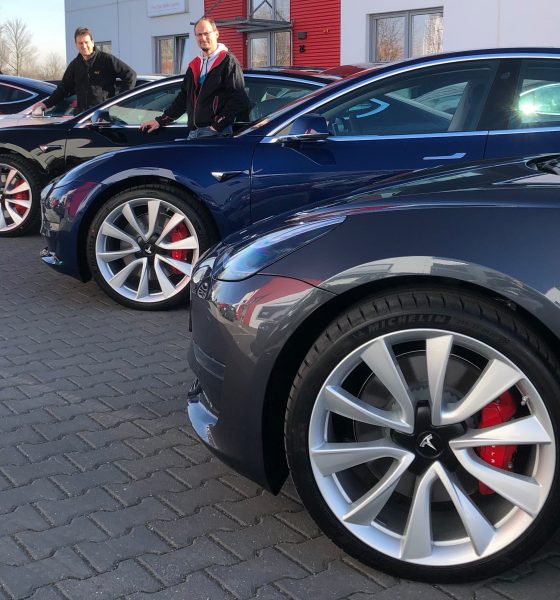

News
Tesla Model 3 dominates sales in California, capturing 30% of alternative fuel cars sold
According to a report issued by the California New Car Dealers Association (CNCDA), Tesla was the number one selling alternative powertrain brand in 2018, representing 29.3% of the total market share. That number includes hybrids, plug-in hybrids, and fuel cell vehicles. When the numbers are limited to battery electric-only vehicle sales, the Model 3 then claims 55% of sales – 51,300 of the total 92,447 sold in 2018. Impressively, the Model 3 sales numbers alone represent more cars sold than the entirety of EV sales in California for 2017 which represents part of an overall increase of about 81% of total EVs sold. CNCDA’s report is good news for the green vehicle industry as a whole and numerically demonstrates Tesla’s leadership in the arena.
Second place for alternative powertrain vehicles in California went to Toyota for the Prius hybrid at 19,366 cars sold; 13,415 for the Prius plug-in hybrid. Chevy’s Volt plug-in hybrid came in 4th at 10,749, and Tesla’s Model S sold 10,120, capping the top 5 vehicle sales with Tesla bookends. Notably, hybrid vehicle sales went down about 20% while plug-in hybrids increased by nearly 40%. Total hybrid sales dropped about half a percent. From these numbers, it certainly seems the consumer market is pointing in the Tesla-type rechargeable direction.
- California Green Vehicle Report 2018. | Credit: CNCDA
- California Green Vehicle Report 2018. | Credit: CNCDA
- California Green Vehicle Report 2018. | Credit: CNCDA
Although the nearly-doubled increase in EV sales from 2017-2018 in California is significant, ICE vehicles still made up around 82% of all California vehicles sold in 2018. Several reasons could factor in the continued consumer preference for gasoline-powered purchases. “California has a long way to go to overcome challenges, support the needs of zero-emission vehicles, and get consumer buy-in for this advanced technology. Factors like charging infrastructure, convenience, range and affordability all come into play when consumers purchase a vehicle,” Chairperson Ted Nicholas said in a statement released by CNCDA with their report. Tesla’s business model obviously has factored in all of these considerations with its Supercharger network, over-the-air updates, owner app offerings, and now, its $35k Standard Range Model 3.
California has set a goal of putting 5 million EVs on its roads by 2030 due to 40% of the state’s greenhouse emissions coming from its transportation industry. Supporting the increase in zero-emission vehicle sales is an obvious part of that goal, meaning that while Tesla’s sales are impressive and market-changing, the state still has a long way to go. “While we continue to see progress on this front, the pace of change is relatively slow, especially in regions of the state that are outside of the San Francisco Bay Area,” Nichols further commented in the report’s release. With new EV offerings coming from a variety of manufacturers over the next two years, including the Model Y and Tesla pickup truck, perhaps the market will speak for the merits and desirability of EVs for itself.

News
Tesla Giga Berlin draws “red line” over IG Metall union’s 35-hour week demands
Factory manager André Thierig has drawn a “red line” against reducing Giga Berlin’s workweek to 35 hours, while highlighting that Tesla has actually increased its workers’ salaries more substantially than other carmakers in the country.

Tesla Giga Berlin has found itself in a new labor dispute in Germany, where union IG Metall is pushing for adoption of a collective agreement to boost wages and implement changes, such as a 35-hour workweek.
In a comment, Giga Berlin manager André Thierig drew a “red line” against reducing Giga Berlin’s workweek to 35 hours, while highlighting that Tesla has actually increased its workers’ salaries more substantially than other carmakers in the country.
Tesla factory manager’s “red line”
Tesla Germany is expected to hold a works council election in 2026, which André Thierig considers very important. As per the Giga Berlin plant manager, Giga Berlin’s plant expansion plans might be put on hold if the election favors the union. He also spoke against some of the changes that IG Metall is seeking to implement in the factory, like a 35-hour week, as noted in an rbb24 report.
“The discussion about a 35-hour week is a red line for me. We will not cross it,” Theirig said.
“(The election) will determine whether we can continue our successful path in the future in an independent, flexible, and unbureaucratic manner. Personally, I cannot imagine that the decision-makers in the USA will continue to push ahead with the factory expansion if the election results favor IG Metall.”
Giga Berlin’s wage increase
IG Metall district manager Jan Otto told the German news agency DPA that without a collective agreement, Tesla’s wages remain significantly below levels at other German car factories. He noted the company excuses this by referencing its lowest pay grade, but added: “The two lowest pay grades are not even used in car factories.”
In response, Tesla noted that it has raised the wages of Gigafactory Berlin’s workers more than their German competitors. Thierig noted that with a collective agreement, Giga Berlin’s workers would have seen a 2% wage increase this year. But thanks to Tesla not being unionized, Gigafactory Berlin workers were able to receive a 4% increase, as noted in a CarUp report.
“There was a wage increase of 2% this year in the current collective agreement. Because we are in a different economic situation than the industry as a whole, we were able to double the wages – by 4%. Since production started, this corresponds to a wage increase of more than 25% in less than four years,” Thierig stated.
News
Tesla is seeing a lot of momentum from young Koreans in their 20s-30s: report
From January to November, young buyers purchased over 21,000 Teslas, putting it far ahead of fellow imported rivals like BMW and Mercedes-Benz.

Tesla has captured the hearts of South Korea’s 20s-30s demographic, emerging as the group’s top-selling imported car brand in 2025. From January to November, young buyers purchased over 21,000 Teslas, putting it far ahead of fellow imported rivals like BMW and Mercedes-Benz.
Industry experts cited by The Economist attributed this “Tesla frenzy” to fandom culture, where buyers prioritize the brand over traditional car attributes, similar to snapping up the latest iPhone.
Model Y dominates among young buyers
Data from the Korea Imported Automobile Association showed that Tesla sold 21,757 vehicles to the 20s-30s demographic through November, compared to BMW’s 13,666 and Mercedes-Benz’s 6,983. The Model Y led the list overwhelmingly, with variants like the standard and Long Range models topping purchases for both young men and women.
Young men bought around 16,000 Teslas, mostly Model Y (over 15,000 units), followed by Model 3. Young women followed a similar pattern, favoring Model Y (3,888 units) and Model 3 (1,083 units). The Cybertruck saw minimal sales in this group.
The Model Y’s appeal lies in its family-friendly SUV design, 400-500 km range, quick acceleration, and spacious cargo, which is ideal for commuting and leisure. The Model 3, on the other hand, serves as an accessible entry point with lower pricing, which is valuable considering the country’s EV subsidies.
The Tesla boom
Experts described Tesla’s popularity as “fandom culture,” where young buyers embrace the brand despite criticisms from skeptics. Professor Lee Ho-geun called Tesla a “typical early adopter brand,” comparing purchases to iPhones.
Professor Kim Pil-soo noted that young people view Tesla more as a gadget than a car, and they are likely drawn by marketing, subsidies, and perceived value. They also tend to overlook news of numerous recalls, which are mostly over-the-air software updates, and controversies tied to the company.
Tesla’s position as Korea’s top import for 2025 seems secured. As noted by the publication, Tesla’s December sales figures have not been reported yet, but market analysts have suggested that Tesla has all but secured the top spot among the country’s imported cars this year.
News
Tesla FSD fleet is nearing 7 billion total miles, including 2.5 billion city miles
As can be seen on Tesla’s official FSD webpage, vehicles equipped with the system have now navigated over 6.99 billion miles.

Tesla’s Full Self-Driving (Supervised) fleet is closing in on almost 7 billion total miles driven, as per data posted by the company on its official FSD webpage.
These figures hint at the massive scale of data fueling Tesla’s rapid FSD improvements, which have been quite notable as of late.
FSD mileage milestones
As can be seen on Tesla’s official FSD webpage, vehicles equipped with the system have now navigated over 6.99 billion miles. Tesla owner and avid FSD tester Whole Mars Catalog also shared a screenshot indicating that from the nearly 7 billion miles traveled by the FSD fleet, more than 2.5 billion miles were driven inside cities.
City miles are particularly valuable for complex urban scenarios like unprotected turns, pedestrian interactions, and traffic lights. This is also the difference-maker for FSD, as only complex solutions, such as Waymo’s self-driving taxis, operate similarly on inner-city streets. And even then, incidents such as the San Francisco blackouts have proven challenging for sensor-rich vehicles like Waymos.
Tesla’s data edge
Tesla has a number of advantages in the autonomous vehicle sector, one of which is the size of its fleet and the number of vehicles training FSD on real-world roads. Tesla’s nearly 7 billion FSD miles then allow the company to roll out updates that make its vehicles behave like they are being driven by experienced drivers, even if they are operating on their own.
So notable are Tesla’s improvements to FSD that NVIDIA Director of Robotics Jim Fan, after experiencing FSD v14, noted that the system is the first AI that passes what he described as a “Physical Turing Test.”
“Despite knowing exactly how robot learning works, I still find it magical watching the steering wheel turn by itself. First it feels surreal, next it becomes routine. Then, like the smartphone, taking it away actively hurts. This is how humanity gets rewired and glued to god-like technologies,” Fan wrote in a post on X.











